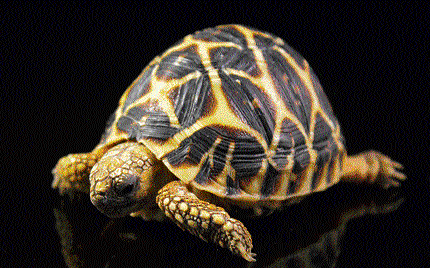
‘Another tiger found dead’. ‘Poachers brutally kill and mutilate a rhino for a horn’. ‘An elephant found dead, tusks gouged out’. News items like these appear in the newspapers every morning. Reactions vary from anger towards the poachers and frustration at the plight of our system to sympathy for the animals killed. But it’s really hard to feel responsible. And perhaps that’s fair.
The average Indian does not go out and buy tiger skins, and even ivory has, fortunately, gone out of fashion. And even if we could buy rhino horn from a store near you, chances are we would not know what to do with it! Yet, we are more closely linked to the wildlife trafficking market than we think we are.
Many of us own (or aspire to own) species of fishes, birds and turtles that may be caught from the wild and even illegally traded. By buying these, we become a part of the growing trade in wildlife that is becoming a prime conservation threat across the world today.
Keeping turtles and tortoises, in Fengshui inspired ‘landscaped’ gardens, we are told, is fashionable. These could be legally traded species, but if you can’t tell a red-eared slider from a red-crowned roofed turtle, we recommend you stay away from this landscaping option.
While the red-eared slider can be legally imported from America, the red-crowned roofed turtle is a ‘critically endangered’ species and would most likely be wild-caught and illegally traded. Indian wildlife laws, in fact, afford it the same level of protection as the tiger. The Indian star tortoise, which is extremely popular as a pet across the world, is relentlessly smuggled out from the forests of India and Sri Lanka in massive numbers. Consignments of hundreds of these tortoises are regularly seized at airports in India and countries in south east Asia.
To buy or not to buy
While the law provides a good baseline, anyone genuinely concerned about wildlife conservation needs to think beyond just whether their pet purchase is legally acceptable. Many wild-caught aquarium fishes are often not protected by law. But that doesn’t always mean that it’s OK to buy these — for conservation reasons. ‘Miss Kerala’ or the red line torpedo barb was recently in the news as it made it to the IUCN Red List as ‘endangered’. It was noted that “populations have declined by more than 50 per cent in the recent past due to indiscriminate exploitation for the international aquarium pet trade”. The combination of stunning good looks and restricted geographic distribution can be quite deadly. In all likelihood, Miss Kerala is just one example of a scenario many other mountain river fish are swimming towards. The story is no different with coral reef fish varieties. While the hit movie, ‘Finding Nemo’ made an instant celebrity of the clownfish, the resultant pet trade devastated wild populations across the world. According to an article that appeared a few years after the release of the movie, the UK alone was importing 1,10,000 clown fish and half of these were wild caught.
In the illegal market
It gets even more complicated — the trader selling you an African gray parrot may assure you it is legally captive-bred, but it would be impossible to verify this in most cases. We recently surveyed a local pet market where we found exotic bird species from across the world, some common, some rare and some protected by international treaties.
The traders claimed they had bought them legally from breeding facilities. But were the breeding facilities getting their birds legally? It was recently discovered that large ‘breeding facilities’ on the Solomon Island were trading thousands of birds to the international market illegally from the wild. This is not the first case where wild caught individuals have been reportedly traded as ‘captive bred’ to bypass trade regulations, dragging thousands of unwitting buys into the illegal trade.
It is simpler when it comes to Indian birds like the rose-ringed parakeet, Alexandrine parakeet, red munia, jungle mynahs and other such species that are naturally found in India and protected under the Wildlife Protection Act.
Free trading of these birds is prohibited under the law. Awareness about the illegality of owning such birds seems to be on the rise. We recently came across a street fortune-teller whose window to the future was a guinea pig instead of the more familiar parakeet. When asked, she sternly said owning the parakeet was illegal. We congratulated her on her awareness, but the change of animal in no way brightened our own forecasts.
In India, we have very good wildlife laws that restrict trade in most Indian wildlife. We are, however, not yet this sensitive to species that do not originate from India. A recent proposal to award the highest legal protection to internationally endangered species that are listed under Appendix I of the Convention on International Trade in Endangered Species (CITES) will hopefully come through soon and correct this too.
It might seem a bit unfair to compare the killing of tigers and rhinos to owning birds and fishes as pets, but if we are motivated to protect wildlife, we need to take on the responsibility and not add to the larger onslaught on nature and wildlife. Do some research to make sure that your proposed pet is legal to trade in and is not an endangered species. Pick a fancy goldfish over the more ‘exotic’ Miss Kerala; safer still, just get a dog.